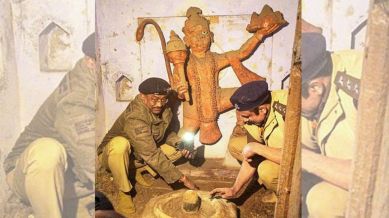Stay updated with the latest - Click here to follow us on Instagram
In Sambhal, district officials reopen ‘ancient temple’ closed since 1978
Officials said a Hanuman statue and a Shivling were found at the temple in Khaggu Sarai area, not far from the Shahi Jama Masjid where a court had ordered a survey last month.

THE DISTRICT administration in Sambhal, Uttar Pradesh, on Saturday reopened an “ancient temple”, which had reportedly been closed since 1978, claiming to have “stumbled upon” it during an ongoing drive against power theft.
Officials said a Hanuman statue and a Shivling were found at the temple in Khaggu Sarai area, not far from the Shahi Jama Masjid where a court had ordered a survey last month. Four persons died on November 24 in violence that broke out over the survey of the Mughal-era mosque which Hindus claim was built by destroying a Hindu temple.
monthly limit of free stories.
with an Express account.
On Thursday, the Supreme Court barred civil courts across the country from registering fresh suits challenging the ownership and title of any place of worship or ordering surveys of disputed religious places until further orders, and made it clear that no “effective” orders can be passed.
In Sambhal, Sub-Divisional Magistrate Vandana Mishra said: “When we were carrying out a drive against power theft, we found a temple. Residents of the area said the temple has been closed since 1978. It has been re-opened and cleaned… The encroachments on the temple will be removed.”
Speaking to The Indian Express, Sambhal District Magistrate Rajender Pensiya said: “We have been conducting a drive against power theft since September 1. As part of the drive, we had come to check illegal power connections in Deepa Sarai and Khaggu Sarai areas. We stumbled upon this temple during the drive and found it to be encroached upon from three sides. Residents told us this is an ancient temple which has not seen devotees since the 1978 riots.”
The district administration, led by Pensiya and Superintendent of Police Krishan Kumar Bishnoi, opened the temple doors and got it cleaned. A well near the temple, which had been filled with debris and soil over the years, was also dug up by the administration. A bulldozer was put to work to clean the open area around the temple.
“The temple is 400-500 years old and had been locked since 1978. We will hand over the temple to the community to which it belongs,” the DM said.
“The temple fell into disuse after the 1978 riots. People say the area once had a mixed population, with about 40 Hindu families living there. However, following the riots, the Hindu families moved to other areas of the town. Since Hindus rarely visit this area, the temple fell into disuse,” said an administration official.
Sources said the administration will now determine the degree of encroachment on the temple premises and take appropriate action.
Meanwhile, police deployed at the site said at least 500 people had visited the temple since it was reopened. Among these were a father and son, who were at the temple at 10 pm. “We stay about 200 metres away… at least 50 people who we know have already visited the temple,” said the father. “Only 20-25 Hindus lived in the area, but have since moved away… the area has always been peaceful,” said his son. Both did not want to be named.
“We have been living here in harmony for ages. The temple is intact… that is proof in itself. Many of our close friends who are Hindus live nearby. They often come to meet us,” said a resident of Khaggu Sarai who did not want to be named.
“We have been stressed since morning… upar waala kabhi to humari bhi sunega… yahan shaanti kaayam rahegi (the almighty will listen to us sometime… peace will prevail here),” said another resident, who, too, did not want to be named.